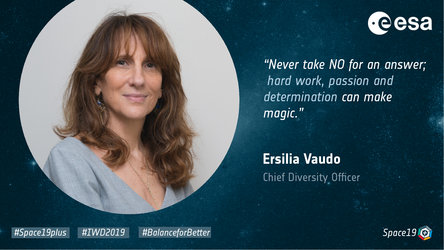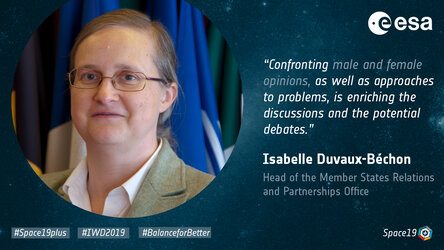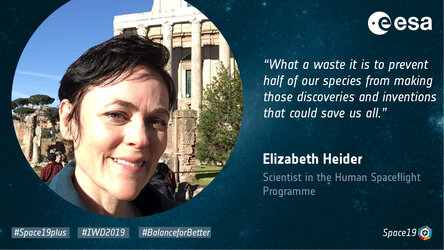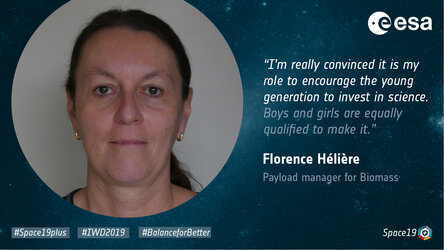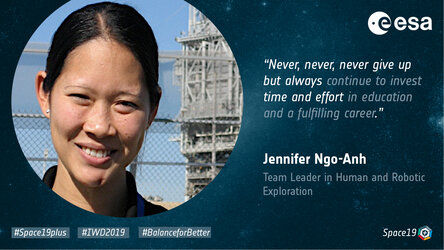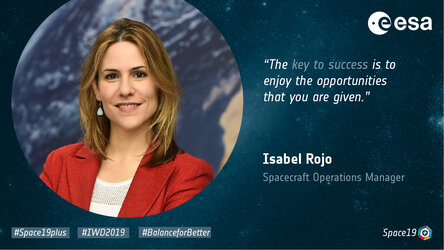Agnès Mestreau-Garreau, Head of ESA Systems Engineering Division
Please give a brief description of your duties at ESA
I have been working for ESA for about 14 years. I started as systems engineer in the Concurrent Design Facility as team leader for assessment studies of future instruments and missions. After four years, I became the project manager of an ESA breakthrough in-orbit demonstration mission called Proba-3. Recently I was nominated as Head of the Systems Engineering Division.
What inspired you to pursue a career in science and engineering and what motivated you to join ESA specifically?
I have always been curious in general, and in particular to know how things work. Engineering answers a lot of questions. Therefore, it was natural for me to study sciences and engineering.
When I was a kid, I was a dreamer. I looked at the stars at night and read science fiction books, among others. I was also part of the generation of the movie ‘The Right Stuff’ and the TV show ‘Space: 1999’. Space was one of the areas that attracted me when I started my professional life. I wanted to participate in space discovery and adventure. I joined ESA after my graduation and then, after a couple of years, I decided to acquire more experience in the space industry before re-joining ESA.
Working at ESA, for me, means participating in unique space missions from their very first concept, through to their operations in space, and witnessing their scientific return. It enables us to contribute to European space programmes through a collaborative effort between different countries in Europe, but also internationally via cooperation with other agencies.
Working at ESA offers an enriching environment with colleagues from different countries, different backgrounds, different ways of thinking. I appreciate this diversity very much, this complementarity, this collaboration.
ESA is really a unique and rewarding place to work.
Did you encounter gender barriers on your way to becoming a scientist / engineer?
During my engineering studies, we were only a few young women. The majority of the students were men. This imbalance still exists but I have not really encountered gender barriers. I have been lucky to meet people who make no distinction between men and women.
I acknowledge that some women may face gender barriers. Hopefully, this mindset is changing. Increasing the balance between men and women in science or engineering studies may help the gender barriers disappear. This will increase the number of women working in these domains, and demonstrate an equal value of contribution between women and men. Both genders benefit from this balance and it has a positive impact on the work itself.
We have a long way to go before the subject of gender inequality or barriers will disappear from our conversations and articles. But I am convinced that we are on the right track.
What progress have you seen in addressing the gender imbalance in your profession through equal-opportunity measures in recent years?
There has been some progress in the gender imbalance in recent years. There are more women in the technical domains, but there are still only a few women at leadership level or project-management level.
I think there are two areas of improvement necessary to address the gender imbalance. Firstly, we need more equal-opportunity measures to avoid bias or pre-conceived views. Secondly, we need an increase in the number of women in science or engineering jobs, as mentioned before. For the latter, the balance should be improved at the base: education. One of the challenges is also to motivate young women to study science or engineering. The more examples there are of women in these domains, the more girls will see science and engineering as possible careers, and their family and schools may then consider, or even encourage, girls to take that direction. Equal-opportunity measures may help to build these examples.
What are, in your view, three measures that could make a difference in supporting a work-life balance and at the same time equal career opportunities.
I think there are different types of measures possible:
- The first one is helping with daily childcare to relieve women from the associated mental stress. For example, a workplace could have a nursery or pre-school, even during the school holidays.
- Another measure would be to encourage identical application of rules for women and men. An example could be ad-hoc teleworking, thus providing flexibility and burden-sharing for men and women so they can face some events or constraints in life without their work being affected. A second example could be parental leave: if it is equally shared between the two parents, the impact on the professional lives of women and men will be identical. Then both should have equal opportunities in their careers.
What advice would you give to a girl or young woman who is considering a career in science and engineering?
I would advise any young woman who is considering a career in science and engineering to be daring, to never let themselves be put down if any barriers appear, to look beyond the fence, to be ready to open doors, to pursue their objectives, and to make their dreams a reality. There are rewarding places in science and engineering for women, as there are for men. Curiosity, perseverance and competence are key.



